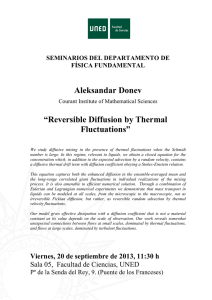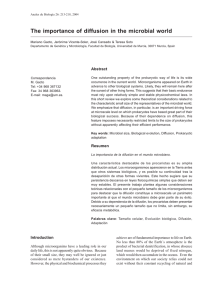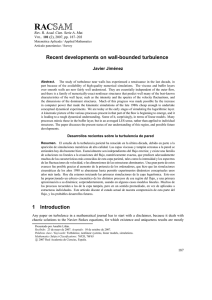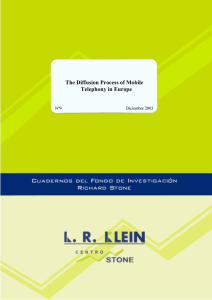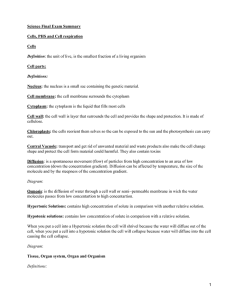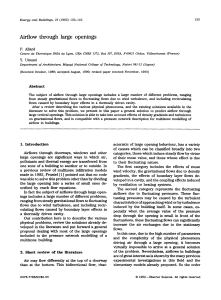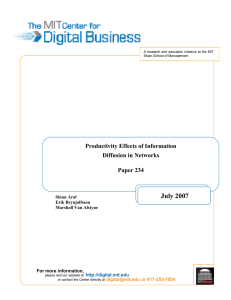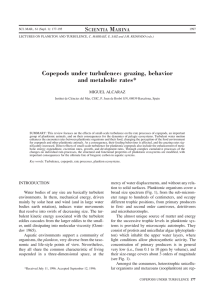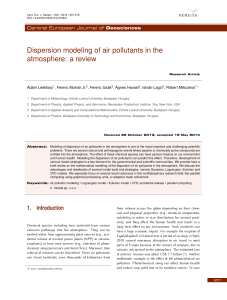Mathematical Modeling Of The Transport Of Pollution In Water
Anuncio
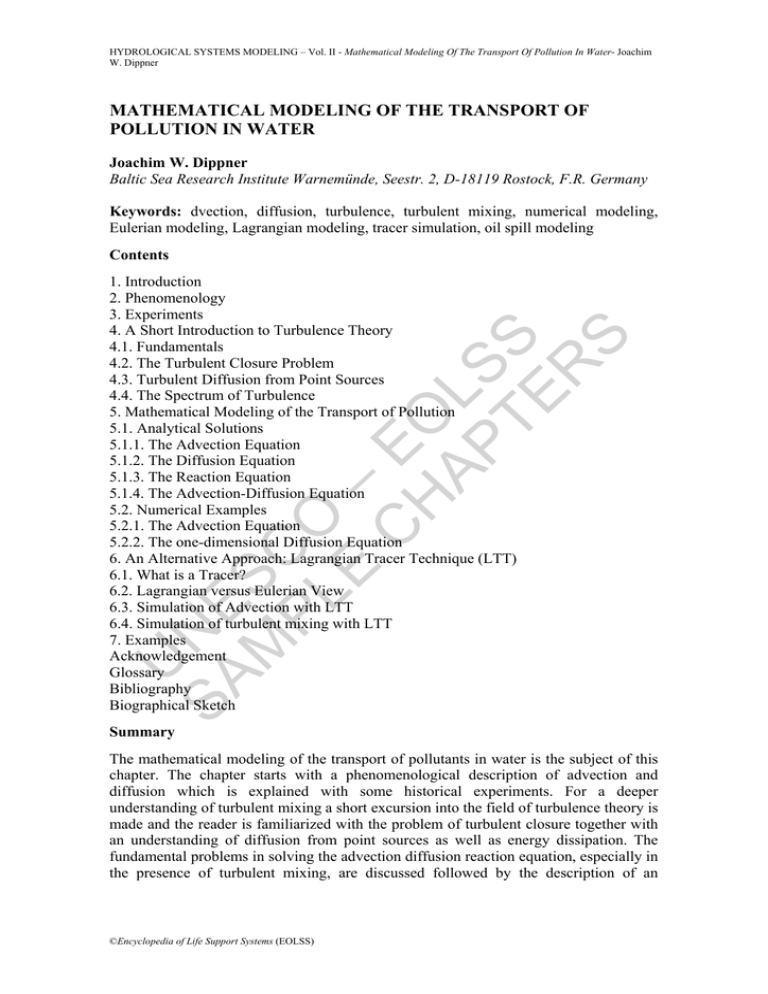
HYDROLOGICAL SYSTEMS MODELING – Vol. II - Mathematical Modeling Of The Transport Of Pollution In Water- Joachim W. Dippner MATHEMATICAL MODELING OF THE TRANSPORT OF POLLUTION IN WATER 1B Joachim W. Dippner Baltic Sea Research Institute Warnemünde, Seestr. 2, D-18119 Rostock, F.R. Germany Keywords: dvection, diffusion, turbulence, turbulent mixing, numerical modeling, Eulerian modeling, Lagrangian modeling, tracer simulation, oil spill modeling Contents U SA NE M SC PL O E – C EO H AP LS TE S R S 1. Introduction 2. Phenomenology 3. Experiments 4. A Short Introduction to Turbulence Theory 4.1. Fundamentals 4.2. The Turbulent Closure Problem 4.3. Turbulent Diffusion from Point Sources 4.4. The Spectrum of Turbulence 5. Mathematical Modeling of the Transport of Pollution 5.1. Analytical Solutions 5.1.1. The Advection Equation 5.1.2. The Diffusion Equation 5.1.3. The Reaction Equation 5.1.4. The Advection-Diffusion Equation 5.2. Numerical Examples 5.2.1. The Advection Equation 5.2.2. The one-dimensional Diffusion Equation 6. An Alternative Approach: Lagrangian Tracer Technique (LTT) 6.1. What is a Tracer? 6.2. Lagrangian versus Eulerian View 6.3. Simulation of Advection with LTT 6.4. Simulation of turbulent mixing with LTT 7. Examples Acknowledgement Glossary Bibliography Biographical Sketch Summary The mathematical modeling of the transport of pollutants in water is the subject of this chapter. The chapter starts with a phenomenological description of advection and diffusion which is explained with some historical experiments. For a deeper understanding of turbulent mixing a short excursion into the field of turbulence theory is made and the reader is familiarized with the problem of turbulent closure together with an understanding of diffusion from point sources as well as energy dissipation. The fundamental problems in solving the advection diffusion reaction equation, especially in the presence of turbulent mixing, are discussed followed by the description of an ©Encyclopedia of Life Support Systems (EOLSS) HYDROLOGICAL SYSTEMS MODELING – Vol. II - Mathematical Modeling Of The Transport Of Pollution In Water- Joachim W. Dippner alternative numerical technique namely the Lagrangian tracer technique. The reader is acquainted with the different perspectives of the Eulerian and the Lagrangian approaches and the method of tracer modeling which is explained in detail. Some examples are presented showing the capability of the Lagrangian tracer technique and the broad field of possible applications. Especially the last example, the oil tanker accident in the western Baltic Sea, shows the way in which the mathematical modeling of the transport of pollutants can support management activities e.g. combating oil spills. The quick and exact forecast combined with expedited clean-up operations makes such model results an important tool, contributing to an improved coastal zone management. 1. Introduction 2B U SA NE M SC PL O E – C EO H AP LS TE S R S Agenda 21 adopted by the United Nations Conference on Environment and Development (UNCED) in Rio de Janeiro, in June 1992, sets out a number of concerns and critical uncertainties that must be addressed urgently by societies and governments concerning the environment and the sustainable development of our planet’s resources. One of these concerns is the future of coastal zones and areas, and integrated coastal zone management is highlighted as a need. The ocean and especially the coastal areas are stressed by the various human uses, since 50% of the population in the industrialized world lives within one kilometer of the coast. This population will grow at about 1.5% per year during the next decades. The use of the coastal zone for the production of food and chemicals (mariculture), for waste disposal, for transportation facilities and for tourism and recreation as well as for possible energy production, commercial fishing and mineral recovery puts stresses upon the marine environment, stresses that are nonlinear with increasing numbers of people (Goldberg 1994). All uses contain the potential risk that harmful substances, dangerous for the marine environment, are introduced into the ocean. The spectrum of substances covers a broad range. It might be synthetic growth hormones or antibiotics in aquaculture, tributylin (TBT) compounds used in antifouling paints, crude oil from oil drilling platforms, illegal dumping or tanker accidents, pesticides like dichloro-diphenyl-trichloroethane (DDT), fungicides like α- or γ- hexachlorocyclohexane (HCH) or industrial products like polychlorinated biphenyls (PCB) entering the ocean via rivers or the atmosphere, and all types of waste material such as municipal solid waste, sewage sludge, dredge materials, wet and solid industrial waste or radio-active waste. In addition, input of high nutrient concentrations of phosphate or nitrate from agriculture through rivers results in strong algae blooms and sometimes in strong oxygen depletion with consequences for near benthic animals or fish larvae. Such strong oxygen depletion was observed in the beginning of the 1980s in the German Bight. In the early 1970s some significant regulatory developments took place at both the national and international levels. Conventions were formulated to limit or perhaps totally stop ocean disposal of wastes. The importance of these conventions rests upon the conviction that the oceans can be seriously damaged by societal activities. The Oslo Convention for the Prevention of Marine Pollution by Dumping from Ships and Aircrafts was adopted on 15 February 1972 by the Scandinavian states that were prompted by the proposed disposal of 650 tons of chlorinated hydrocarbons in the northern part of the North Sea. This action provided the stepping stone to other ©Encyclopedia of Life Support Systems (EOLSS) HYDROLOGICAL SYSTEMS MODELING – Vol. II - Mathematical Modeling Of The Transport Of Pollution In Water- Joachim W. Dippner U SA NE M SC PL O E – C EO H AP LS TE S R S agreements. The Helsinki Convention on the protection of the Marine Environment of the Baltic Sea area was adopted in 1974 and the Barcelona Convention for the Protection of the Mediterranean against pollution in 1976. The London Dumping Convention, which was first signed by 57 countries in 1972, now has 91 signatories. The London Dumping Convention addresses global concerns; the others are directed to more specific regional problems. These Conventions respond to scientific understanding of how ocean resources can be jeopardized by the entry of toxic substances or benign material that threatens living organisms. Some endeavor to prevent all ocean disposals where alternate land options are available; the others seek specific regulations as to what materials can or cannot be discarded in the oceans. The International Maritime Organisation (IMO) has brought together a Convention for the Prevention of Marine Pollution from Ships (MARPOL) which has been adopted by 57 countries representing over 85% of the world’s merchant fleet. The Convention prohibits the disposal of plastics from ships and strongly regulates the way other rubbish such as food wastes, papers, metal cans, etc. can be dropped into the oceans from ships. These provisions have been extended to platforms and drilling rigs. Finally, certain marine areas especially vulnerable to pollution because they are landlocked or environmentally sensitive have been designated by MARPOL as “Special Areas”. These include the North Sea, the Mediterranean Sea, the Bering Sea, the Red Sea, and the Baltic Sea. All dumping is prohibited with the exception of food wastes which can be discarded twelve nautical miles off land. In spite of the existence of these Conventions, the potential risk of environmental pollution is always present due to increased use of the ocean and near coastal areas, increased ship traffic, technical defects or human errors. Each dissolved or particulate substance entering the ocean is subject to transport and diffusion and the prediction of the spreading of the substance is an important aspect in coastal zone management. The description of the mathematical modeling of transport of pollutants is subject of this chapter. In Section 2 diffusion is explained phenomenologically. In Section 3 some diffusion experiments are presented and a short introduction to turbulence theory is given in Section 4. Section 5 deals with various analytical solutions of the advectiondiffusion-reaction (ADR) equations and the general numerical difficulties in solving this equation are described. In Section 6 the numerical method of Lagrangian tracer technique (LTT) is introduced and described. Finally, in Section 7, different applications of LTT are presented and discussed. 2. Phenomenology 3B The problem of advection and diffusion of any arbitrary substance in the atmosphere or the ocean can be visualized by looking at a cloud or a plume leaving a chimney. Compared to the extension of the atmosphere the chimney can be considered as a point source where the concentration is highest. The plume is transported by the wind in a certain direction and becomes broader and broader. After a certain distance the plume has become so large that it is invisible. Then the concentrations are very small or zero. This simple example includes phenomenologically all aspects of transport problems, and, the transport of pollutants or harmful substances are a part of it. Figure 1 shows a simple sketch illustrating the main processes involved. ©Encyclopedia of Life Support Systems (EOLSS) HYDROLOGICAL SYSTEMS MODELING – Vol. II - Mathematical Modeling Of The Transport Of Pollution In Water- Joachim W. Dippner Figure 1: Schematic sketch of advection and diffusion. U SA NE M SC PL O E – C EO H AP LS TE S R S In the upper panel a particle at a specific time t0 and position is considered. This particle is transported by the wind in the atmosphere or by currents in the ocean and has at time t1 a new position. If only two snap shots exist at t0 and t1, the way of the particle is unknown. It could have been transported the shortest direct way or any arbitrary random way. This process is, in general, known as transport or advection. In the lower panel two particles are considered which have at a certain time t0 certain positions and a distance between the two particles of x0. Both particles are advected, each on its own pathway, and have at time t1 new positions and a distance x1. An increase in the distance from x0 to x1 is, in general, understood as a process which is named diffusion. How does diffusion work? Besides the mean circulation, turbulent motion exists in the atmosphere and the ocean. It covers a broad spectrum of turbulent cells of different sizes (Stommel 1949). Diffusion, or more precisely turbulent diffusion, in contrast to molecular diffusion, is directly connected to turbulent motion. Turbulence itself is not exactly defined in physics, since it covers various processes of different time and length scales. The use of the term “turbulence” depends, in essence, on averaging in time or in space and when the deviations from averaged quantities are considered as turbulent. The dependence of the term turbulence from temporal or spatial scales leads to the definition of a turbulent cell which represents a component of the spectrum of the velocity field. The length scale in the ocean or the atmosphere can range from an averaged free path of a molecule to global circulation. The question, whether advection or diffusion takes place, depends on the size of a turbulent cell in relation to the size of the plume. If the turbulent cell is very large compared to the plume, then, the whole plume is transported as it is. Hence, large turbulent cells contribute to the mean circulation or advection. In contrast, if the turbulent cell is small compared to the plume, a spreading of the plume occurs which can be described as a movement of a concentration away from its center of mass. Therefore, small turbulent cells contribute to diffusion. The third case is the situation when the turbulent cell has approximately the same size as the plume. Then, turbulence causes a deformation of the plume. Hence, middle size turbulent cells cause a shear and the spatial variation of the mean flow field causes a deformation of the plume. In addition, as can be seen in a plume coming out of a chimney, the size of the plume increases with time. That means that during the whole process, starting with the plume coming out of a chimney until the plume disappears, a continuous shift occurs, with turbulent cell sizes that initially contribute to advection, later contributing to diffusion due to the increase of the plume size. This example illustrates that turbulent diffusion is somehow time dependent. This will be one of the subjects of the next two sections. ©Encyclopedia of Life Support Systems (EOLSS) HYDROLOGICAL SYSTEMS MODELING – Vol. II - Mathematical Modeling Of The Transport Of Pollution In Water- Joachim W. Dippner Figure 2 shows schematically the spreading of a plume for constant flow (a), a shear current (b), and a meandering plume (c) after Okubo (1970). U SA NE M SC PL O E – C EO H AP LS TE S R S Figure 2: Schematic spreading of a plume for (a) a uniform flow field, (b) a shear current field, and (c) a meandering patch modified after Okubo A. (1970) Oceanic mixing. Chesapeake Bay Institute, The John Hopkins University, Technical Report Nr. 62. 3. Experiments 4B Various experiments have been carried out to investigate advection and turbulent mixing or diffusion in the ocean. At the end of the 19th century Fulton (1897) made a message in a bottle experiment to investigate the drift of fish eggs and larvae. He deployed 2074 bottles in September 1894 in the North Sea, of which 502 were found. The result of this experiment was the first map of the circulation in the North Sea. A similar experiment with a message in a bottle was made by Krümmel (1904) from April 1900 to May 1901. He deployed bottles close to the lightvessel West-Hinder off of the Dutch coast. The result of this experiment was a qualitative map of the circulation in the southern North Sea. Such experiments were repeated later with drift cards by Stommel (1949) or Neumann (1966). Figure 3 shows as an example two batches of paper floats diffusing on the sea surface. Such experiments have a limited meaningfulness for three reasons. The difference between the time when the message in a bottle or the drift card reach the coast and the time when the bottle or card is found, is unknown. Secondly, the way of the drifters through the water is also unknown. Finally, the probability of retrieval of the drifters decreases with increasing distance from the place of release. Figure 3: Two batches of paper floats diffusing on the sea surface after Stommel (1949). The boat gives a measure of the scale of the phenomenon. Source: Stommel H. (1949) Horizontal diffusion due to oceanic turbulence, Journal of Marine Research, 8:199-225. ©Encyclopedia of Life Support Systems (EOLSS) HYDROLOGICAL SYSTEMS MODELING – Vol. II - Mathematical Modeling Of The Transport Of Pollution In Water- Joachim W. Dippner These uncertainties have been the reason why further diffusion experiments have been designed with other substances. For the investigation of diffusion processes, the substance must fulfill the following conditions: U SA NE M SC PL O E – C EO H AP LS TE S R S a) The substance must characterize a diffusion process, i.e. the substance should not exist in the ocean, so that no natural background noise exists. b) The substance must be biologically harmless, i.e. it should not be toxic nor be subject to biological enrichment or decay processes. c) The substance should naturally decay in time scales larger than the duration of the diffusion experiment. d) The substance must be detectable at extremely low concentrations, so that diffusion can be observed as long as possible over larger areas. This also requires very sensitive measuring equipment. e) Continuous observations of the substance should be made possible from a moving ship. f) The substance should adjust very quickly to the density of the surrounding sea water to avoid sinking to the sea floor or drifting on the sea surface. Figure 4: Dye patch release of rhodamine B in the North Sea after Joseph et al. (1964). Left: colored water from a distance of 4 m (pink = transparent color, yellow red = fluorescence color). Right: distribution half an hour after release of 175 kg rhodamine B. Source: Joseph J., Sendner H. and Weidemann H. (1964) Investigation of the horizontal diffusion in the North Sea. Deutsche Hydrographische Zeitschrift, 17:57-75. (in German). With kind permission of the Federal Maritime Agency, Hamburg. Figure 5: Left: three snap shots of the size of a rhodamine B patch in the German Bight after Joseph et al. (1964). Right: four snap shots of a similar experiment in the northern North Sea. The thin lines crossing the patch mark the ship’s track during the measurements. Source: Joseph J., Sendner H. and Weidemann H. (1964) Investigation ©Encyclopedia of Life Support Systems (EOLSS) HYDROLOGICAL SYSTEMS MODELING – Vol. II - Mathematical Modeling Of The Transport Of Pollution In Water- Joachim W. Dippner of the horizontal diffusion in the North Sea. Deutsche Hydrographische Zeitschrift, 17:57-75. (in German). With kind permission of the Federal Maritime Agency, Hamburg. U SA NE M SC PL O E – C EO H AP LS TE S R S Some experiments have been made with radioactive substance (Folsom and Vine 1957) and other authors have used various dyes. A substance which fulfills nearly all criteria is rhodamine B, an acetic fluid with an intensive red color, firstly used by Pritchard and Carpenter (1960). Rhodamine B can be measured with a fluorometer from a moving ship down to concentrations of 10-11 kg m-3. Figure 4 shows two pictures of an experiment with 175 kg rhodamine B in the North Sea. The left picture shows the release of the rhodamine B and the right picture half an hour later. At the early stage of the experiment, when the dye patch is still visible and not very large compared to the ship, qualitative measurements are made by circling the patch and noting the ship’s position to obtain a first view of the patch. Later on, if the patch is very large compared to the ship’s length and the disturbance of the ship is of minor importance, the ship crosses the patch with a towed undulating CTD system which is equipped with a fluorometer. In contrast to the first circling which results in a two-dimensional view of the patch, the observation with the undulating fluorometer gives a complete threedimensional view of the development of the patch. Figure 5 shows the two-dimensional temporal development of two dye patch experiments in the German Bight and in the northern North Sea (Joseph et al. 1964). These experiments were designed to investigate three-dimensional isotropic turbulence (Joseph and Sendner 1958). Years later, similar experiments were made at fronts to investigate two-dimensional anisotropic turbulence which appears due to the instability of a frontal system and the associated meandering of the front and the detachment of eddies. At fronts, a dye patch is stretched and nearly no cross-isopycnal mixing occurs, a process which prevents isotropic mixing. The frontal system and the presence of eddies results in two-dimensional turbulence where only stirring occurs but no turbulent mixing. They can be explained phenomenologically with a cup of tea. Consider a cup of tea, add sugar, take a spoon, and stir the tea. The result will be a rotating fluid with a depression at the surface and opposite of it a little sugar hill at the bottom of the cup. In this case no or nearly no turbulent mixing occurs. However, if random movements are made with the spoon in the tea, then, threedimensional turbulence is created dissolving the sugar in the tea. Two-dimensional turbulence is often called “quasi-geostrophic turbulence” in physical oceanography (Rhines1979). Figure 6: Vertical distribution of rhodamine B concentration in ng l-1 combined with the density field expressed as density parameter γ (kg m-3) on a profile from the island of Rügen in north-northeast direction into the Baltic Sea. Source: Giese H., unpublished data. With kind permission of the author. ©Encyclopedia of Life Support Systems (EOLSS) HYDROLOGICAL SYSTEMS MODELING – Vol. II - Mathematical Modeling Of The Transport Of Pollution In Water- Joachim W. Dippner U SA NE M SC PL O E – C EO H AP LS TE S R S In January 1997, an experiment was carried out in the framework of CIRDEX (CIRculation and Diapycnal EXchange). The aim of the experiment in the Baltic Proper was to obtain a consistent three-dimensional picture of the dispersal of dense deep water from the Arkona to the Bornholm Basin by means of tracer experiments. To investigate the effects of mixing and entrainment of the dense sill overflow, two patches of fluorescent non-toxic dyes were released onto the lowest pycnocline above the dense bottom water and observed until September 1997. Figure 6 shows as an example the vertical distribution of rhodamine B concentration in ng l-1 combined with the density field expressed as the density parameter γ (kg m-3) on a profile from the island of Rügen in a north-northeast direction. The dye spreads along the γ=9 kgm-3 density layer with a vertical thickness between 1 and 2 meters. The high resolution of the CTD data in this experiment also enables the identification of overturns which arise by the breaking of internal waves and the associated turbulent mixing . Figure 7: A diffusion diagram illustrating the variance of the patch versus the diffusion time after Okubo (1971). Source: Okubo A. (1971) Oceanic diffusion diagrams, Deep Sea Research, 18:789-802, with kind permission from Elsevier Science. Many of the experiments which have been carried out are summarized in a review article by Okubo (1971). He collected data from 20 instantaneous dye-release experiments and developed for time scales from two hours to one month and length scales from 30 m to 100 km two kinds of “diffusion diagrams” and compared them with similarity theories of turbulence. Consider a patch having a major and a minor principal axes with a variance of σ2x in one and of σ2y in the other direction of the axes. If the distribution of the patch is Gaussian, then the variance σ2 for a radially symmetrical distribution is obtained by taking the equivalent radius: σ2=2σxσy. Plotting the variance σ2 against diffusion time t, the basic diffusion diagram (Figure 7) is obtained in which the fitted line gives the relation: σ 2 = 0.0108t 2.34 (1) This relation is often called the 7/3 power law. In a second diffusion diagram, the apparent diffusivity Ka is plotted against the scale of diffusion l, defined as 3σ, and a fitted line gives the relation: K a = 0.0103l1.15 (2) The deeper meaning of these two relations will be discussed in the next section in which a short introduction to turbulence theory is presented. ©Encyclopedia of Life Support Systems (EOLSS) HYDROLOGICAL SYSTEMS MODELING – Vol. II - Mathematical Modeling Of The Transport Of Pollution In Water- Joachim W. Dippner - TO ACCESS ALL THE 42 PAGES OF THIS CHAPTER, Visit: http://www.eolss.net/Eolss-sampleAllChapter.aspx Bibliography 0B Abramowitz M. and Stegun I.A. (1970). Handbook of Mathematical Functions with Formulas. Graphs, and Mathematical Tables, Dover Publications, Inc., New York, 1046pp. [A mathematical handbook]. U SA NE M SC PL O E – C EO H AP LS TE S R S Arakawa A. and Lamb V. (1977). Computational design of the basic dynamical processes of the UCLA general circulation model, Methods in Computational Physics, 17:173-265. [An overview article in numerical methods]. Berntsen J., Skagen D.W. and Svendsen E. (1984). Modelling the transport of particles in the North Sea with reference to sandeel larvae. Fisheries Oceanography, 3:81-91. [A numerical application with active tracers]. Boris J.P. and Book D.L. (1976). Solution of continuity equation by the method of flux-corrected transport, Methods in Computational Physics, 16:85-129. [An article on the numerical method of FTC]. Bork I. and Maier-Reimer E. (1978). On the spreading of power plant cooling water in a tidal river applied to the river Elbe. Advances in Water Research, 1(3):161-168. [An application of LTT to the spreading of nuclear power plant cooling water]. Bugliarello G. and Jackson E.D. (1964). Random walk study of convective diffusion. ASCE Journal of the Engineer. Mechanics Division, 94:312-322. [On of the first principle studies in LTT]. Boussinesq J. (1897). Theory of the whirling and turbulent flow of liquids. Gauthier-Villars, VI, 76pp Paris. (in French). [A classical paper in physics of fluids]. Crank J. (1956) The Mathematics of Diffusion. Clarandon Press, Oxford UK, 347pp. [A classical text book of the mathematical solution of parabolic diffusion equations]. Dippner J.W. (1980). Numerical simulation of horizontal transport of vertical migrating zooplankton, Mitteilung des Instituts für Meereskunde der Universität Hamburg, 23, 63-113. (in German) [A model application of active tracers using vertical migrating zooplankton as property of the Lagrangian tracers]. Dippner J.W. (1983). A Hindcast of the Bravo Ekofisk Blow-Out, Veröffentlichung des Instituts für Meeresforschung Bremerhaven, 19:245-257. [Application of LTT to the problem of oil spills]. Dippner J.W. (1984). A Circulation and Oil Spill Model for the German Bight, Veröffentlichungen des Instituts für Meeresforschung Bremerhaven, Suppl. 8, 187pp (in German) [Application of LTT to the problem of oil spills]. Dippner J.W. (1990). Eddy-resolving modelling with dynamically active tracers. Continental Shelf Research, 10:87-101. [An eddy-resolving model using density of sea water as property of the tracers]. Dippner J.W. (1993a). A Lagrangian model of phytoplankton growth dynamics for the Northern Adriatic Sea, Continental Shelf Research, 13, 331-355. [A model application using three interactive tracers: phosphate, phytoplankton, and zooplankton]. Dippner J.W. (1993b). Larvae survival due to eddy activity and related phenomena in the German Bight. Journal of Marine Systems, 4:303-313. [An analysis of eddy activity on the spreading of sprat larvae]. Dippner J.W. (1993c). A frontal resolving model for the German Bight. Continental Shelf Research, 13:49-66. [An eddy-resolving model using density of sea water as property of the tracers]. ©Encyclopedia of Life Support Systems (EOLSS) HYDROLOGICAL SYSTEMS MODELING – Vol. II - Mathematical Modeling Of The Transport Of Pollution In Water- Joachim W. Dippner Dippner J.W. (1998). Competition between different groups of phytoplankton for nutrients in the southern North Sea. Journal of Marine Research, 14:181-198. [A numerical ecosystem simulation using interactive tracers]. Einstein A. (1905). On the from the molecular kinetic theory of heat required motion of suspended particles in resting water, Annalen der Physik, 4:549-560. (in German) [A classical paper in theoretical physics]. Folsom T.R. and Vine A.C. (1957). On the tagging of water masses for the study of physical processes in the ocean. In: The effects of atomic radiation on oceanography and fisheries. Washington: National Academy of Science. – National Research Council Publication, 551, 121 pp. [Description of a diffusion experiment with radio-active tracers] Frank P. and von Mises R. (1961). The Differential and Integral Equations in Mechanics and Physics, Vol.II :Physical Part, 1106 pp. Friedrich Vieweg & Sohn, Braunschweig (in German) [This contains a comprehensive description of many physical problems and their analytical solutions]. U SA NE M SC PL O E – C EO H AP LS TE S R S Franz H. (1989). Ocean turbulence, Landolt-Börnstein New Series V/3b, (ed. J. Sündermann) 151-210, Springer Verlag Berlin, Germany [An excellent overview of the existing knowledge in ocean turbulence]. Fulton T.W. (1897). The surface currents in the North Sea. Scottish Geographical Magazine, 636-645. [An experiment using message in a bottle as drifter to identify the circulation in the North Sea and the transport of fish larvae]. Goldberg E.D. (1994). Coastal zone space – Predude to conflict? IOC Ocean Forum, UNESCO Publishing, Paris, 138 pp. [This booklet gives a comprehensive overview on potential risks and conflicts in coastal zone management]. Harten A. (1978). The artificial compression method for computation of shocks and contact discontinuities, Mathematical Computation, 32:363-389.[An article describing different advection schemes]. Heisenberg W. (1948). Statistical theory of turbulence, Zeitschrift für Physik, 124:628-657. (in German) [A classical paper in turbulence theory]. James I.D. (1996). Advection schemes for shelf sea models. Journal of Marine Systems, 8:237-254. [A comparison of various advection schemes]. James I.D. (2000). A high-performance explicit vertical advection scheme for ocean models: how PPM can beat the CFL condition. Applied Mathematical Modelling, 24:1-9. [A comparison of advection schemes]. Joseph J. and Sendner H. (1958). The horizontal diffusion in the ocean. Deutsche Hydrographische Zeitschrift, 11:49-77. (in German) [Description of a diffusion experiment]. Joseph J., Sendner H. and Weidemann H. (1964). Investigation on the horizontal diffusion in the North Sea. Deutsche Hydrographische Zeitschrift, 17:57-75. (in German) [Description of three diffusion experiments in the North Sea]. Kautsky H. (1973). The distribution of the radio nuclide Caesium 137 as an indicator for North Sea watermass transport. Deutsche Hydrographische Zeitschrift, 26:241-246. [Observations of the distribution of radio nuclides in the North Sea]. Kok J.M. de (1994). Numerical Modeling of Transport Processes in Coastal Waters. Ministry of Transport, Public Works and Water Management, Directorate-Generale of Public Works and Water Management, National Institute for Coastal and Marine Management/RIKZ, Den Haag, 158 pp. [Development and application of various advection schemes]. Kolmogorov A.N. (1941). The local structure of turbulence in incompressible viscous fluid for very large Reynolds’ numbers. Doklady Akademia Nauk SSSR, 30:301-305. (in Russian) [A classical paper in turbulence theory]. Krümmel O. (1904). The oceans of Germany in the context of international marine research. Veröffentlichungen des Instituts für Meereskunde und des geographischen Instituts an der Universität Berlin, Nr. 6, 36 pp. (in German) [Description of a experiment with message in a bottle]. ©Encyclopedia of Life Support Systems (EOLSS) HYDROLOGICAL SYSTEMS MODELING – Vol. II - Mathematical Modeling Of The Transport Of Pollution In Water- Joachim W. Dippner Kundu P.K. (1990). Fluid Mechanics. Academic Press Inc., San Diego, 638 pp. [A text book in fluid mechanics]. Maier-Reimer E. (1973). Hydrodynamical numerical investigation on horizontal dispersion and transport processes in the North Sea, Mitteilungen des Institutes für Meereskunde der Universität Hamburg, Nr 21, 96 pp (in German) [In this paper various numerical schemes for solving the ADR equation are compared]. Maier-Reimer E. (1977). Residual circulation in the North Sea due to the M2-tide and mean annual wind stress. Deutsche Hydrographische Zeitschrift, 30:69-80. [A numerical application of LTT using Cs-137 as property of the tracers]. Maier-Reimer E. (1978). On the formation of salt wedges in estuaries, Mathematical Modelling in Estuarine Physics, ( ed. Sündermann J. and Holz K.P.) Springer Verlag, Berlin, 91-101. [An numerical application of dynamical active tracers using salinity as property of the tracers]. Maier-Reimer E. and Sündermann J. (1982) On tracer method in computational hydrodynamics, Engineering Application of Computation Hydraulics (ed. Abott M.B. and Cunge J.A.), Pitman, London, 198-217. [An overview on possible physical applications of LTT]. U SA NE M SC PL O E – C EO H AP LS TE S R S Maier-Reimer E. (1988). Vorticity balance in Gulf Stream trajectories. Ocean Modelling, 76:9-11. [A numerical study using vorticity as property of the Lagrangian tracers]. Mellor G.L. and Yamada T. (1974). A hierarchy of turbulence closure models for planetary boundary layers. Journal of Atmospheric Science, 31:1791-1806. [A review article on turbulence closure schemes]. Neumann H. (1966). The relation between wind and surface circulation derived from an experiment with drift cards, Deutsche Hydrographische Zeitschrift, 19:253-266. (in German) [Description of an experiment with drift cards]. Obukhov A.M. (1941). On the distribution of energy in the spectrum of turbulent flow. Doklady Akademia Nauk SSSR, 32:22-24. (in Russian) [A classical paper in turbulence theory] Okubo A. (1970). Oceanic mixing. Chesapeake Bay Institute, The John Hopkins University, Technical Report Nr. 62. [An overview in the knowledge of mixing processes in the ocean]. Okubo A. (1971). Oceanic diffusion diagrams, Deep Sea Research, 18:789-802. [An overview on various diffusion experiments and the development of diffusion diagrams]. Onsager L. (1945). The distribution of of energy in turbulence. (abstract only) Physical Review, 2. Ser., 68:286. [A classical paper in turbulence theory]. Ozmidov R.V. (1958). On the calculation of horizontal diffusion of pollutant patches in the sea. Doklady Akademia Nauk SSSR 120:761-763. (in Russian) [A classical paper in turbulence theory]. Pavia E.G. and Cushman-Roisin B. (1988). Modeling oceanic fronts using a particle method. Journal of Geophysical Research, 93:3554-3562. [A numerical study using potential height as property of the Lagrangian tracers]. Phillips O.M. (1977). The Dynamics of the Upper Ocean. Cambridge University Press, Cambridge, UK, 336pp. [A standard text book in physical oceanography]. Prandtl L. (1925). Fully developed turbulence. Zeitschrift für angewandte Mathematik und Mechanik, 5:136-139. (in German) [A first order turbulent closure scheme]. Pritchard D.W. and Carpenter J.H. (1960). Measurements of turbulent diffusion in estuarine and inshore waters. Bulletin of the International Association of Scientific Hydrology, No 20, 37-50. [Description of a diffusion experiment] Reynolds O. (1895). On the dynamical theory of incompressible viscous fluids and the determination of the criterion. Philosophical Transaction of the Royal Society, London (A), 186:123-164. [A classical paper in fluid mechanics]. Rhines P.B. (1979). Geostrophic turbulence. Annual Review of Fluid Mechanics, 11:401-441. [A review article in two-dimensional geostrophic turbulence]. Richardson L.F. (1926). Atmospheric diffusion shown on a distance neighbour graph. Proceedings of the Royal Society London (A), 110:709-727. [A classical paper in turbulence theory]. ©Encyclopedia of Life Support Systems (EOLSS) HYDROLOGICAL SYSTEMS MODELING – Vol. II - Mathematical Modeling Of The Transport Of Pollution In Water- Joachim W. Dippner Richardson P.L. (1981). Gulf Stream trajectories measured with free-drifting buoys. Journal of Physical Oceanography, 11:999-1010. [Description of a long-term experiment with drifting buoys in the Gulf Stream]. Roache P.J. (1976). Computational Fluid Dynamics, Hermosa Publisher, Albuquerque, NM, USA 446 pp. [This book presents a comprehensive description of many numerical algorithms for partial differential equations in fluid dynamics]. Rodi W. (1993). Turbulence models and their application in hydraulics. A state-of-the-art review. IAHR/AIRH. Monograph, Balkema, Rotterdam, 104 pp [A comprehensive overview in turbulence closure schemes and models]. Schmidt W. (1925). The mass exchange in free air and related phenomena. Henri Grand, Hamburg, VIII, 118pp (in German) [A classical paper in physics of fluids]. Smolarkiewicz P.K. (1983). A simple positive definite advection scheme with small implicit diffusion, Monthly Weather Review, 111(3):479-86. [An article on the numerical methods in FTC]. U SA NE M SC PL O E – C EO H AP LS TE S R S Stommel H. (1949). Horizontal diffusion due to oceanic turbulence, Journal of Marine Reasearch, 8:199225. [An important paper in turbulence theory]. Taylor G.I. (1922). Diffusion by continuous movements. Proceedings of the London Mathematical Society, 20:196-212. [A classical paper in turbulence theory]. Taylor G.I. (1935). The statistical theory of turbulence. Introduction and Summary of Parts I-IV. Proceedings of the Royal Society London(A), 151:421-454. [A classical paper in turbulence theory]. Taylor G.I. (1938). The spectrum of turbulence. Proceedings of the Royal Society London(A), 164:476490. [A classical paper in turbulence theory] Weizsäcker C.F. von (1948). The spectrum of turbulence at large Reynolds numbers, Zeitschrift für Physik, 124:614-627.(in German) [A classical paper in turbulence theory]. Woods J.D. and Onken R. (1982). Diurnal variation and primary production in the ocean -preliminary results of a Lagrangian ensemble model. Journal of Plankton Research, 4:735-756.[A model study using phytoplankton as property of interactive tracers]. Zorita Calvo M. (1996). Turbulence characteristics of Gulf Stream trajectories in a quasi-geostrophic circulation model using Lagrangian vorticity tracers. Max-Planck-Institut für Meteorologie, Examensarbeit, Nr. 37, 117 pp. (in German) [A numerical study of turbulence in the Gulf Stream using potential vorticity as property of the tracers]. Biographical Sketch 1B Dr. Joachim W. Dippner, born in 1949, studied physical oceanography, meteorology, geophysics, theoretical physics and applied mathematics at the University of Hamburg. He has a Diploma in physical oceanography, a Doctor dissertation in physical oceanography, Thesis: “A Mathematical Model for Drift, Spreading, and Weathering of Crude Oil for the German Bight” and a Doctor habilitation in physical oceanography. Thesis: “Investigation of Transient Eddies in the German Bight”. He is an expert in numerical modeling and statistical analyses. His research interests are ecosystem theory, ecosystem modeling and climate induced variability in biological systems. In 1999 he granted of the mare research price for his studies on “Climate variability in near coastal marine ecosystems”.He worked in various German research institutes, in England, Italy, Norway and Poland. Details might be found under: http://www.io-warnemuende.de/homepages/dippner/index.html ©Encyclopedia of Life Support Systems (EOLSS)
